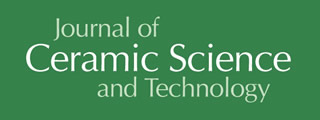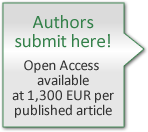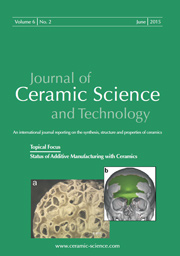Articles
All articles | Recent articles
Pressureless Sintering of Luminescent CaAlSiN3:Eu Ceramics
I. Pricha1, W. Rossner1, R. Moos2
1 Siemens AG, Corporate Technology, Research & Technology Center, Otto-Hahn-Ring 6, 81739 Munich, Germany
2 Department of Functional Materials, University of Bayreuth, 95440 Bayreuth
received October 31, 2014, received in revised form December 31, 2014, accepted January 13, 2015
Vol. 6, No. 1, Pages 63-68 DOI: 10.4416/JCST2014-00047
Abstract
CaAlSiN3:Eu powder compacts were pressureless-sintered in a nitrogen atmosphere between 1400 and 1800 °C. The sintering behavior and the dependence of the luminescence properties on the sintering temperature were investigated. It is shown for the first time that it is possible to sinter CaAlSiN3:Eu ceramics that efficiently emit light starting from a micrometer-sized phosphor powder optimized for high luminescence efficiency. The maximum densities of the ceramics were achieved at ≥ 1700 °C and are limited to 80 % of the solid-state density owing to inhomogeneities of the powder compacts caused by the applied binder-free dry-pressing procedure. The phase composition of the ceramic specimens as well as the luminescence properties remained unchanged during sintering. These results demonstrate that pressureless sintering is suitable for fabricating CaAlSiN3:Eu bulk ceramics that can be used for LED applications.
![]() Download Full Article (PDF)
Download Full Article (PDF)
Keywords
CaAlSiN3:Eu, pressureless sintering, luminescence properties, LED
References
1 Xie, R.-J., Hirosaki, N.: Silicon-based oxynitride and nitride phosphors for white LEDs - A review, Sci. Technol. Adv. Mat., 8, 588 – 600, (2007).
2 Chen, L., et al.: Light converting inorganic phosphors for white light-emitting diodes, Materials, 3, 2172 – 2195, (2010).
3 Xie, R.-J., Hirosaki, N., Takeda, T.: Rare-earth activated nitride phosphors: synthesis, luminescence and applications, Materials, 3, 3777 – 3793, (2010).
4 Xie, R.-J., et al.: 2-phosphor converted while light-emitting diodes using oxynitride/nitride phosphors, Appl. Phys. Lett., 90, 191101, (2007).
5 Xie, R.-J., et al.: White light-emitting diodes (LEDs) using (Oxy)nitride phosphors, J. Phys. D: Appl. Phys., 41, 144013, (2008)
6 Xie, R.-J., Hintzen, H.T.: Optical properties of (Oxy) nitride Materials: A review, J. Am. Ceram. Soc., 96, 665 – 687, (2013).
7 He, X.-H., et al.: Dependence of luminescence properties on composition of rare-earth activated (Oxy)nitrides phosphors for White-LEDs applications, J. Mater. Sci., 44, 4763 – 4775, (2009).
8 Li, Y.Q., et al.: Yellow-Orange-emitting CaAlSiN3:Ce3+ Phosphor: structure, photoluminescence and application in White-LEDs, Chem. Mater., 20, 6704 – 6714, (2008).
9 Zhang, B., Mukherjee, R., Fujii, H., Miyagawa, H., Guang, P., Nakamura, T., Mochizuki, A.: Garnet-based phosphor ceramic sheets for light emitting device, U.S. Patent application 2011/0227477A1 (2011).
10 Wang, J.-Q., et al.: Preparation of transparent yttrium aluminum garnet ceramics by relatively low temperature solid-state reaction, T. Nonferr. Metal Soc., 13, 1096 – 1101, (2003).
11 Michalik, D., et al.: Preparation of translucent YAG:Ce ceramics by reaction, IOP Conf. Ser.: Mater. Sci. Eng., 35, 012018, (2012).
12 Nishiura, S., et al.: Preparation and optical properties of transparent Ce:YAG ceramics for high power white LED, IOP Conf. Ser.: Mater. Sci. Eng., 1, 012031, (2009).
13 Li, J.-G., et al.: Low-temperature fabrication of transparent yttrium aluminum garnet (YAG) ceramics without additives, J. Am. Ceram. Soc., 83, 961 – 963, (2000).
14 Park, Y.-J., et al.: The densification and photoluminescence characteristics of Ca-α-SiAlON:Eu2+ plate phosphor, Journal of the Korean Ceramic Society, 50, 280 – 287, (2013).
15 Krames, M.R., Schmidt, P.J.:Luminescent ceramic element for a light emitting device. U.S. Patent application 20090155943 (2009).
16. Krames, M.R., Schmidt, P.J.: Luminescent ceramic element for a light emitting device. U.S. Patent application 20070126017 (2007).
17 Meyer, J., Schmidt, P.J., Bechtel, H.-H., Mayr, W., Schreinemacher, B.-S., Heidemann, M.: Red emitting SiAlON-based material. U.S. Patent 8441026 B2 (2013).
Copyright
Göller Verlag GmbH


